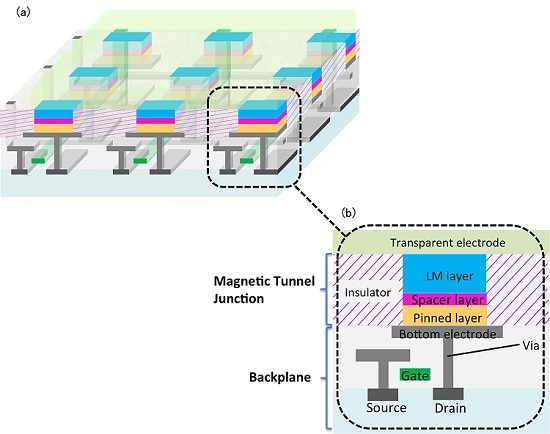Two Micron Pixel Pitch Active Matrix Spatial Light Modulator Driven by Spin Transfer Switching
Abstract
:1. Introduction
2. Spin-SLM
2.1. Structure and Operation of the Spin-SLM
2.2. Magnetic Field-Assisted STS in MTJ Device
2.3. Fabrication of an Active Matrix Spin-SLM
2.4. Electrical Characteristics of the Active Matrix Spin-SLM
2.5. Magneto-Optical Properties of the Active Matrix Spin-SLM
3. Conclusions
Acknowledgments
Author Contributions
Conflicts of Interest
References
- Gabor, D. A new microscopic principle. Nature 1948, 161, 777–778. [Google Scholar] [CrossRef] [PubMed]
- Leith, E.N.; Upatnieks, J. Reconstructed wavefronts and communication theory. J. Opt. Soc. Am. 1962, 52, 1123–1128. [Google Scholar] [CrossRef]
- Senoh, T.; Mishina, T.; Yamamoto, K.; Oi, R.; Kurita, T. Viewing-zone-angle-expanded color electronic holography system using ultra-high-definition liquid crystal displays with undesirable light elimination. J. Disp. Technol. 2011, 7, 382–390. [Google Scholar] [CrossRef]
- Psaltis, D.; Paek, E.G.; Venkatesh, S.S. Optical image correlation with a binary spatial light modulator. Opt. Eng. 1984, 23, 698–704. [Google Scholar] [CrossRef]
- Mok, F.; Diep, J.; Liu, H.; Psaltis, D. Real-time computer-generated hologram by means of liquid-crystal television spatial light modulator. Opt. Lett. 1986, 11, 748–750. [Google Scholar] [CrossRef] [PubMed]
- Hashimoto, N.; Morokawa, S.; Kitamura, K. Real-time holography using the high-resolution LCTV-SLM. Proc. SPIE 1991, 1461. [Google Scholar] [CrossRef]
- Sonehara, T.; Miura, H.; Amako, J. Moving 3D-CGH reconstruction using a liquid crystal spatial wavefront modulator. In Proceedings of the 12th International Display Research Conferences, Hiroshima, Japan, 12–14 Octobre 1992; p. 315.
- Takaki, Y.; Hayashi, Y. Increased horizontal viewing zone angle of a hologram by resolution redistribution of a spatial light modulator. Appl. Opt. 2008, 47, D6–D11. [Google Scholar] [CrossRef] [PubMed]
- Mishina, T.; Okui, M.; Okano, F. Viewing-zone enlargement method for sampled hologram that uses high-order diffraction. Appl. Opt. 2002, 41, 1489–1499. [Google Scholar] [CrossRef] [PubMed]
- Aoshima, K.; Funabashi, N.; Machida, K.; Miyamoto, Y.; Kawamura, N.; Kuga, K.; Shimidzu, N.; Sato, F.; Kimura, T.; Otani, Y. Spin transfer switching in current-perpendicular-to-plane spin valve observed by magneto-optical Kerr effect using visible light. Appl. Phys. Lett. 2007, 91. [Google Scholar] [CrossRef]
- Aoshima, K.; Funabashi, N.; Machida, K.; Miyamoto, Y.; Kuga, K.; Ishibashi, T.; Shimidzu, N.; Sato, F. Submicron magneto-optical spatial light modulation device for holographic displays driven by spin-polarized electrons. J. Disp. Technol. 2010, 6, 374–380. [Google Scholar] [CrossRef]
- Aoshima, K.; Machida, K.; Kato, D.; Mishina, T.; Wada, K.; Cai, Y.; Kinjo, H.; Kuga, K.; Ishibashi, T.; Kikuchi, H.; et al. A magneto-optical spatial light modulator driven by spin transfer switching for 3D holography applications. J. Disp. Technol. 2015, 11, 129–134. [Google Scholar] [CrossRef]
- Kinjo, H.; Machida, K.; Matsui, K.; Aoshima, K.; Kato, D.; Kuga, K.; Kikuchi, H.; Shimidzu, N. Low-current-density spin-transfer switching in Gd22Fe78-MgO magnetic tunnel. J. Appl. Phys. 2014, 115. [Google Scholar] [CrossRef]
- Aoshima, K. Magneto-optical spatial light modulator driven by Si based MOSFET backplane for holography display. In Proceedings of the 21st International Display Workshops, Niigata, Japan, 3–5 December 2014; pp. 1247–1258.
- Yakushiji, K.; Noma, K.; Saruya, T.; Kubota, H.; Fukushima, A.; Nagahama, T.; Yuasa, S.; Ando, K. High magnetoresistance ratio and low resistance–area product in magnetic tunnel junctions with perpendicularly magnetized electrodes. Appl. Phys. Exp. 2010, 3. [Google Scholar] [CrossRef]
- Goto, S.; Tang, S.; Aoshima, K.; Machida, K.; Kuga, K.; Kikuchi, H.; Shimidzu, N.; Ishibashi, T. Simulation of magneto-optical properties of GMR structures for SLM. In Proceedings of the 59th Spring Meeting of the Japan Society of Applied Physics, Tokyo, Japan, 15–18 March 2012; pp. 10–100.
- Goto, S.; Machida, K.; Aoshima, K.; Kuga, K.; Kikuchi, H.; Shimidzu, N.; Ishibashi, T. Magneto-optical properties of (Pt/Co)/X/IZO (X = Ta, Au, Pt, Ru, and Ag) structures for magneto-optical light modulator. EPJ Web Conf. 2013, 40. [Google Scholar] [CrossRef]
- Diao, Z.; Apalkov, D.; Pakala, M.; Ding, Y.; Panchula, A.; Huai, Y. Spin transfer switching and spin polarization in magnetic tunnel junctions with MgO and AlOx barriers. Appl. Phys. Lett. 2005, 87. [Google Scholar] [CrossRef]
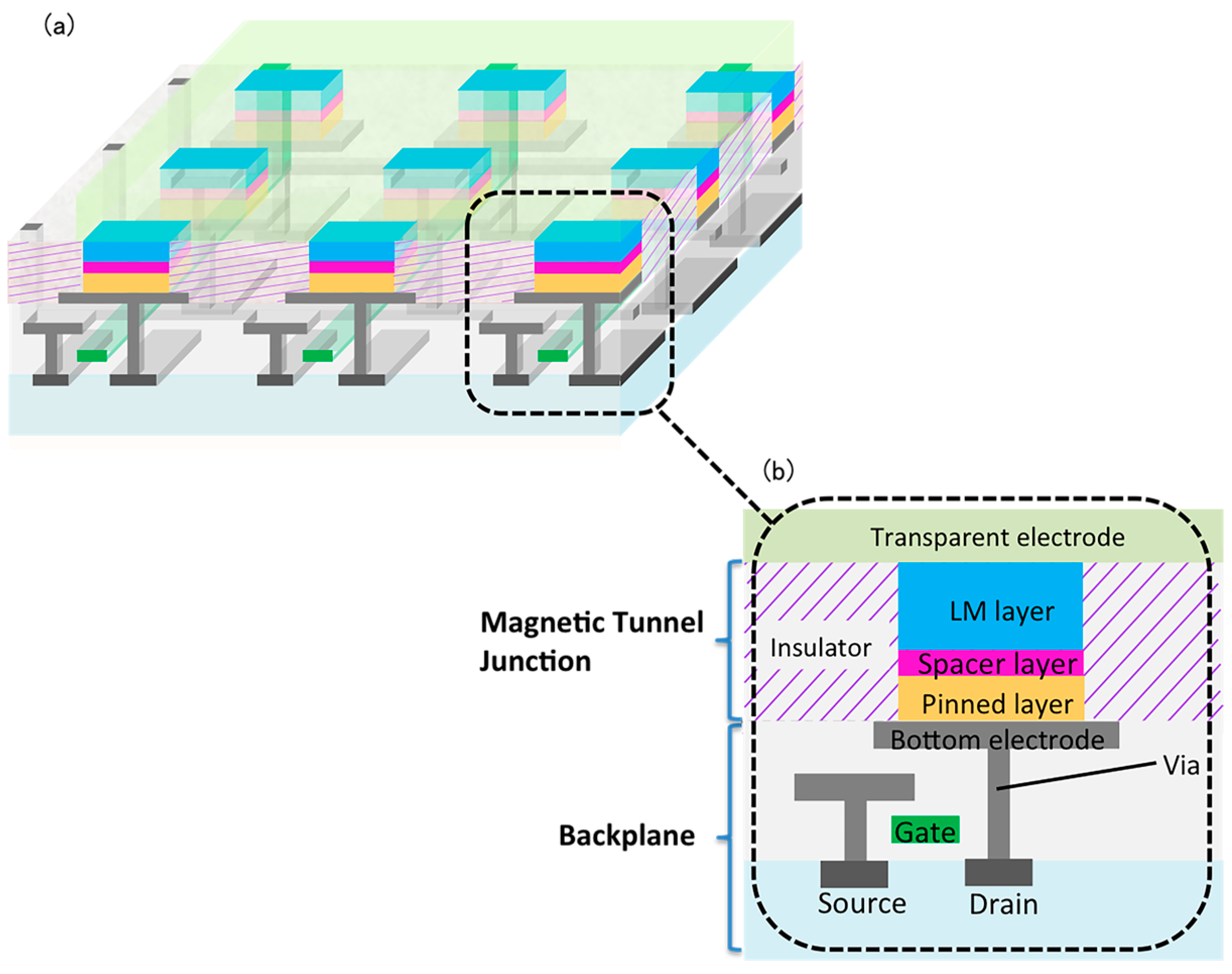
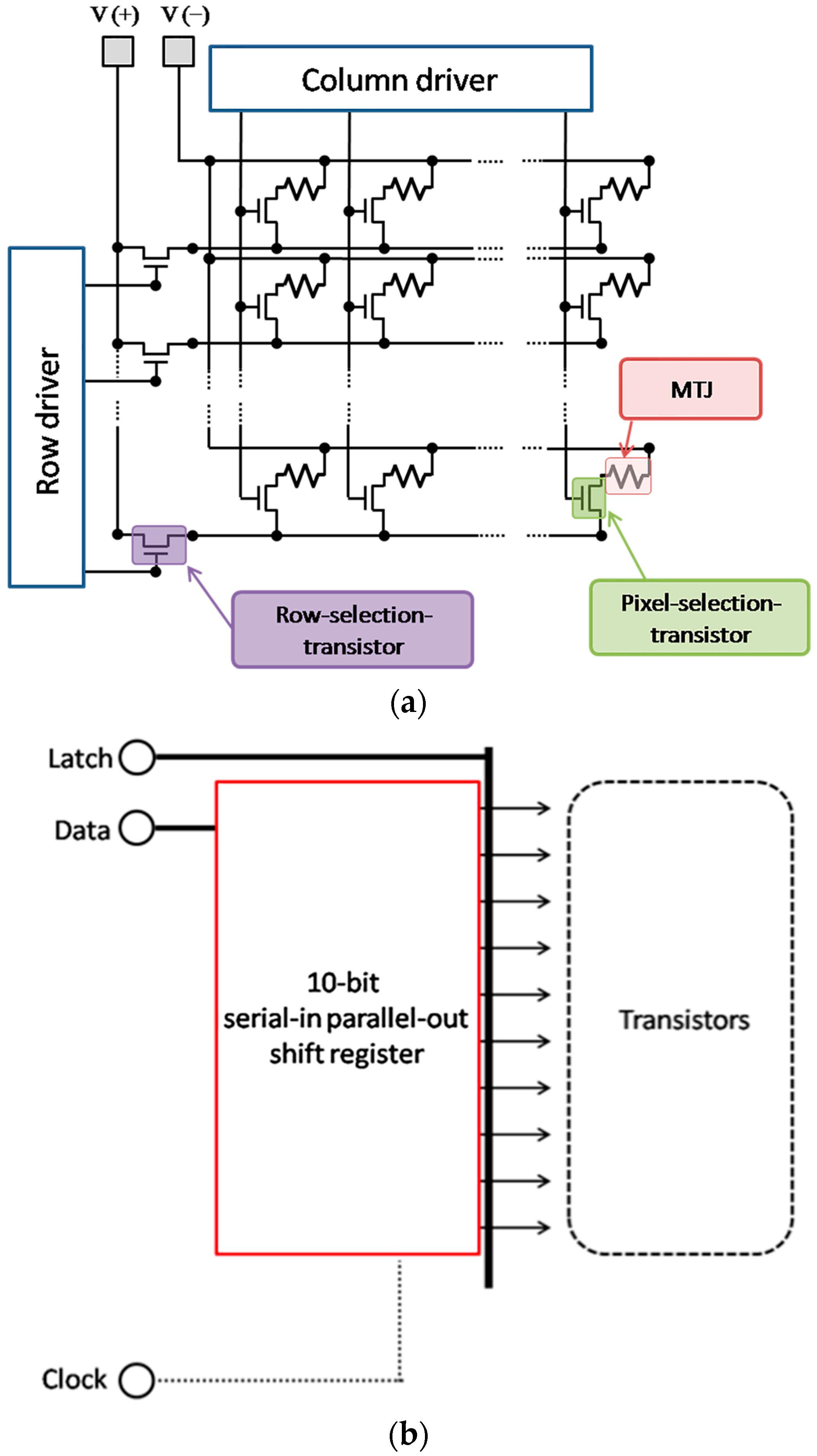
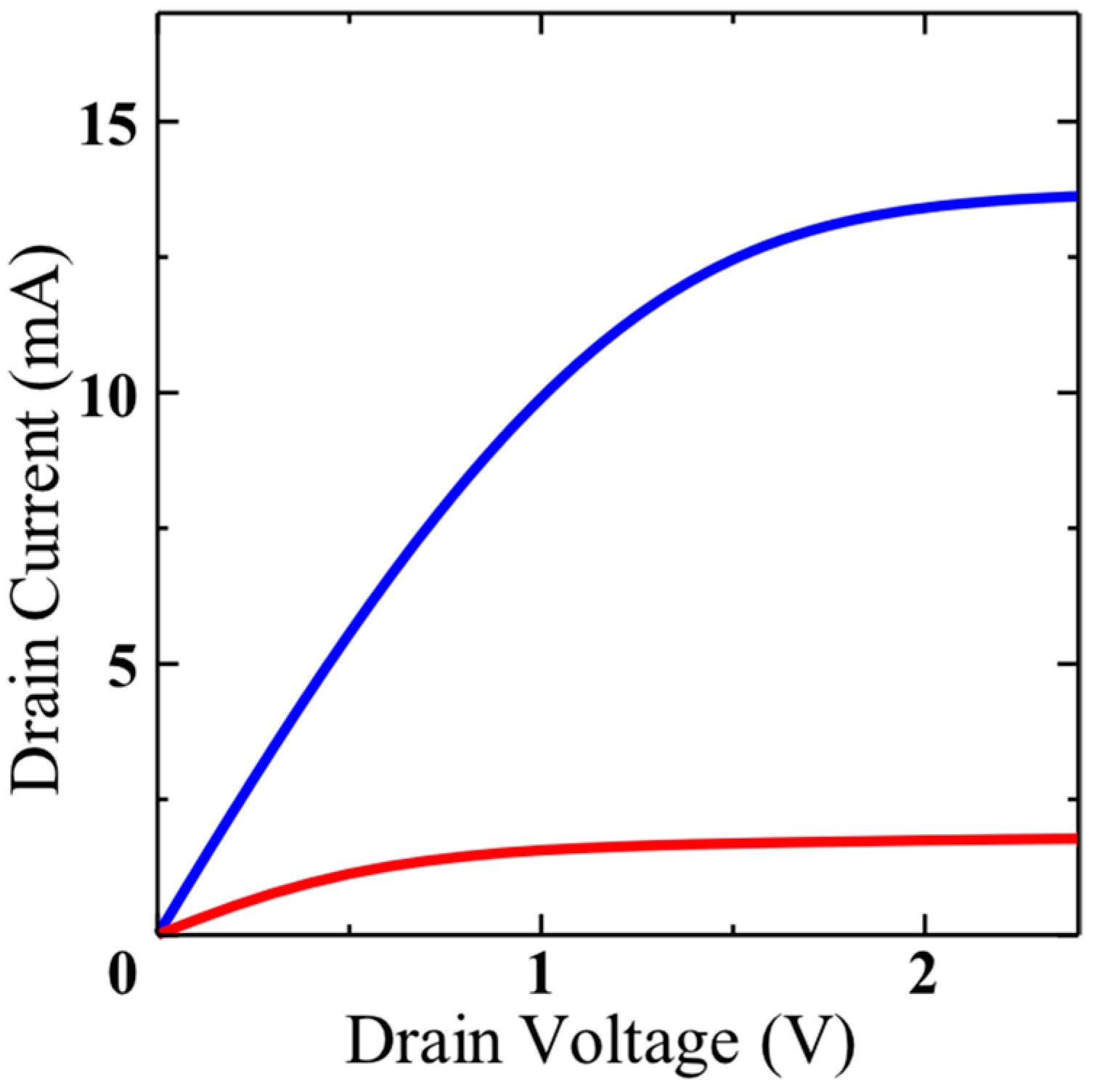
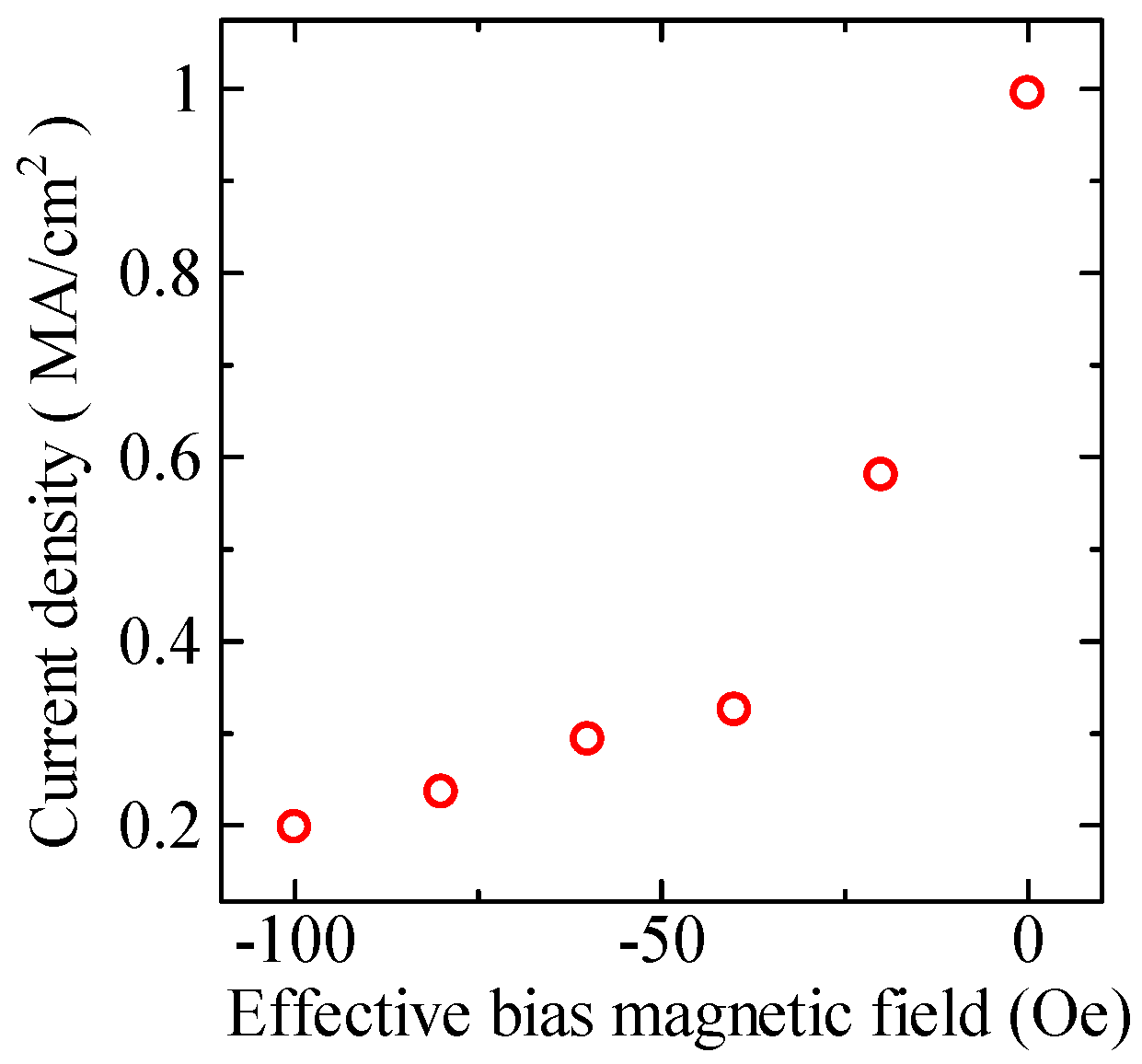
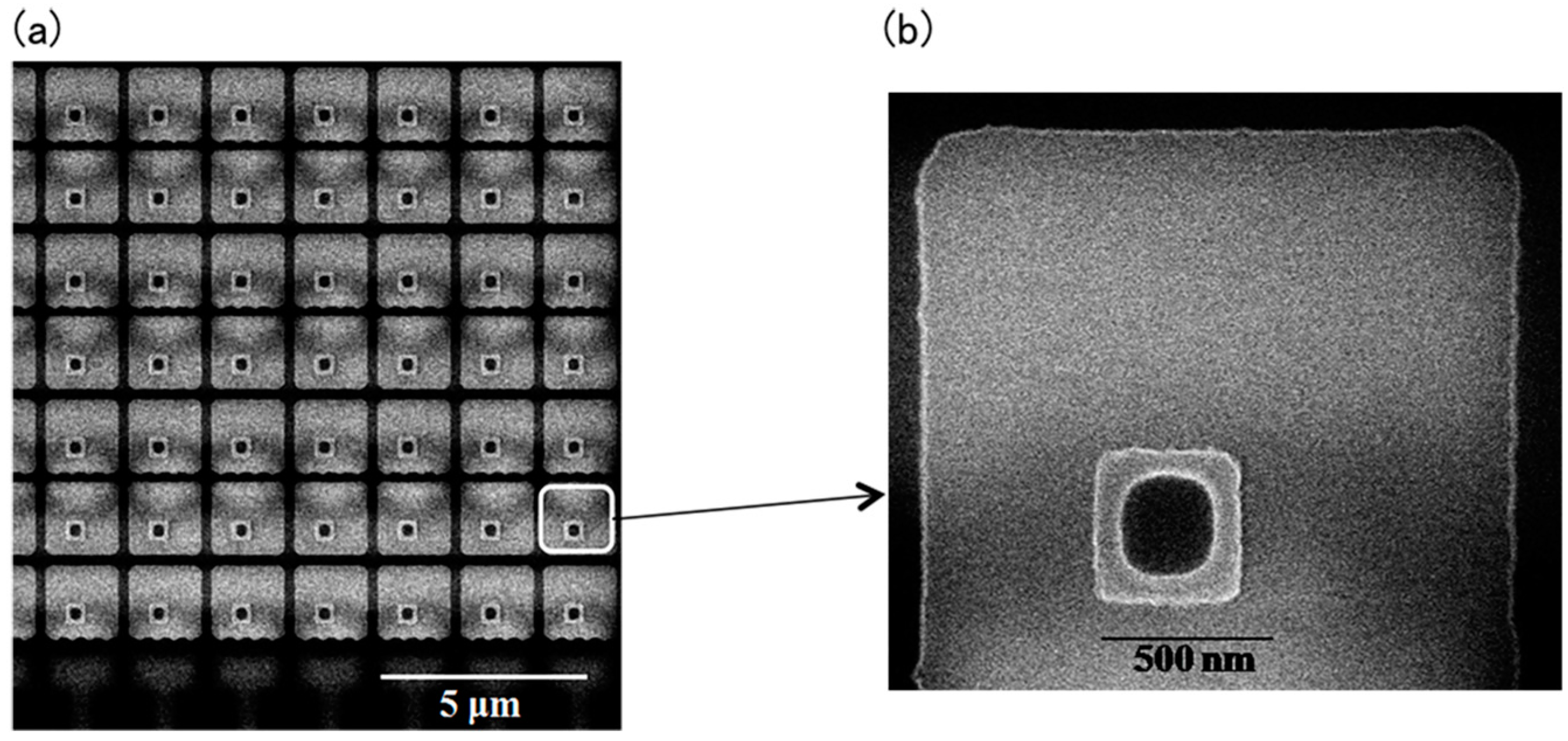
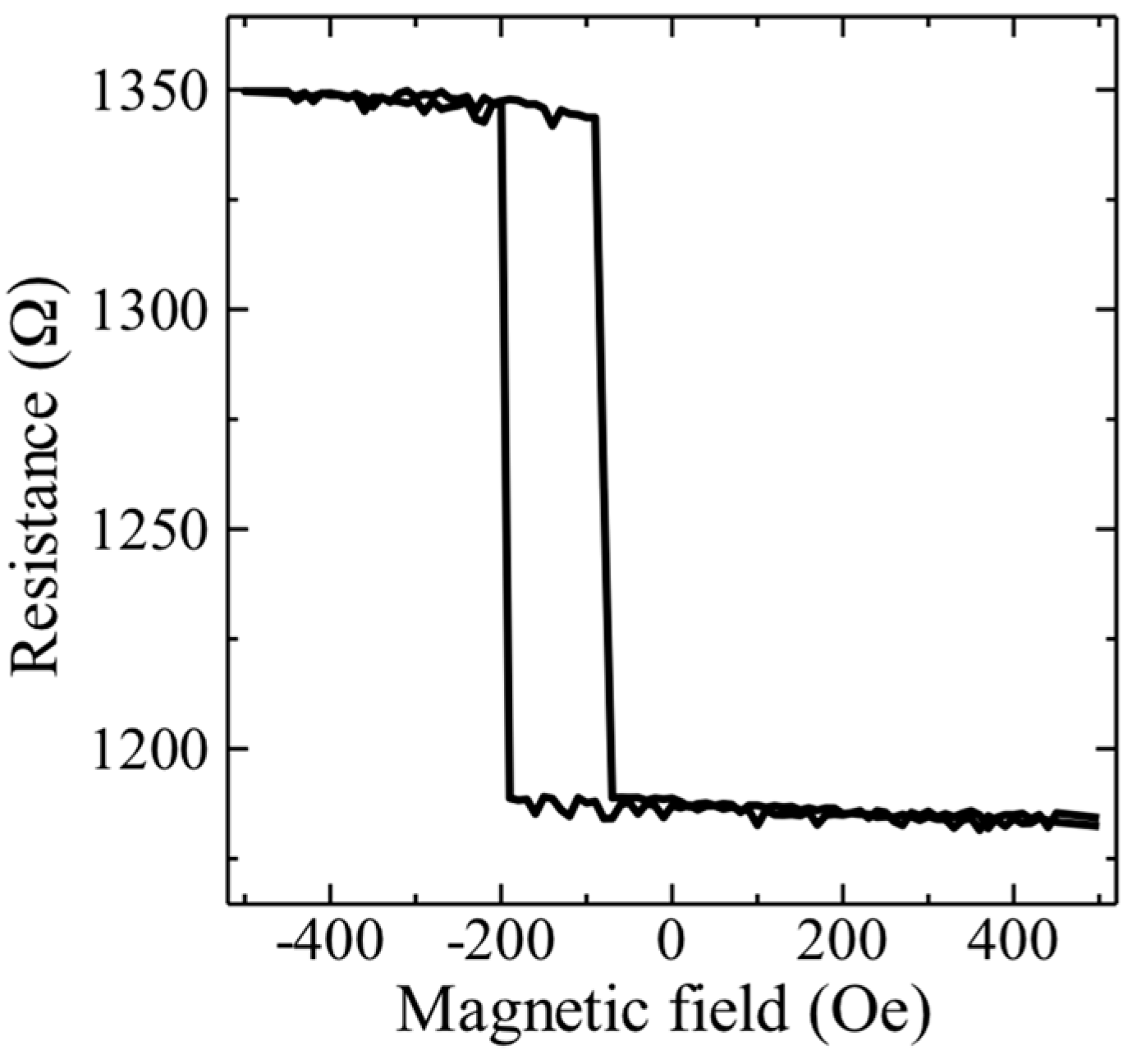
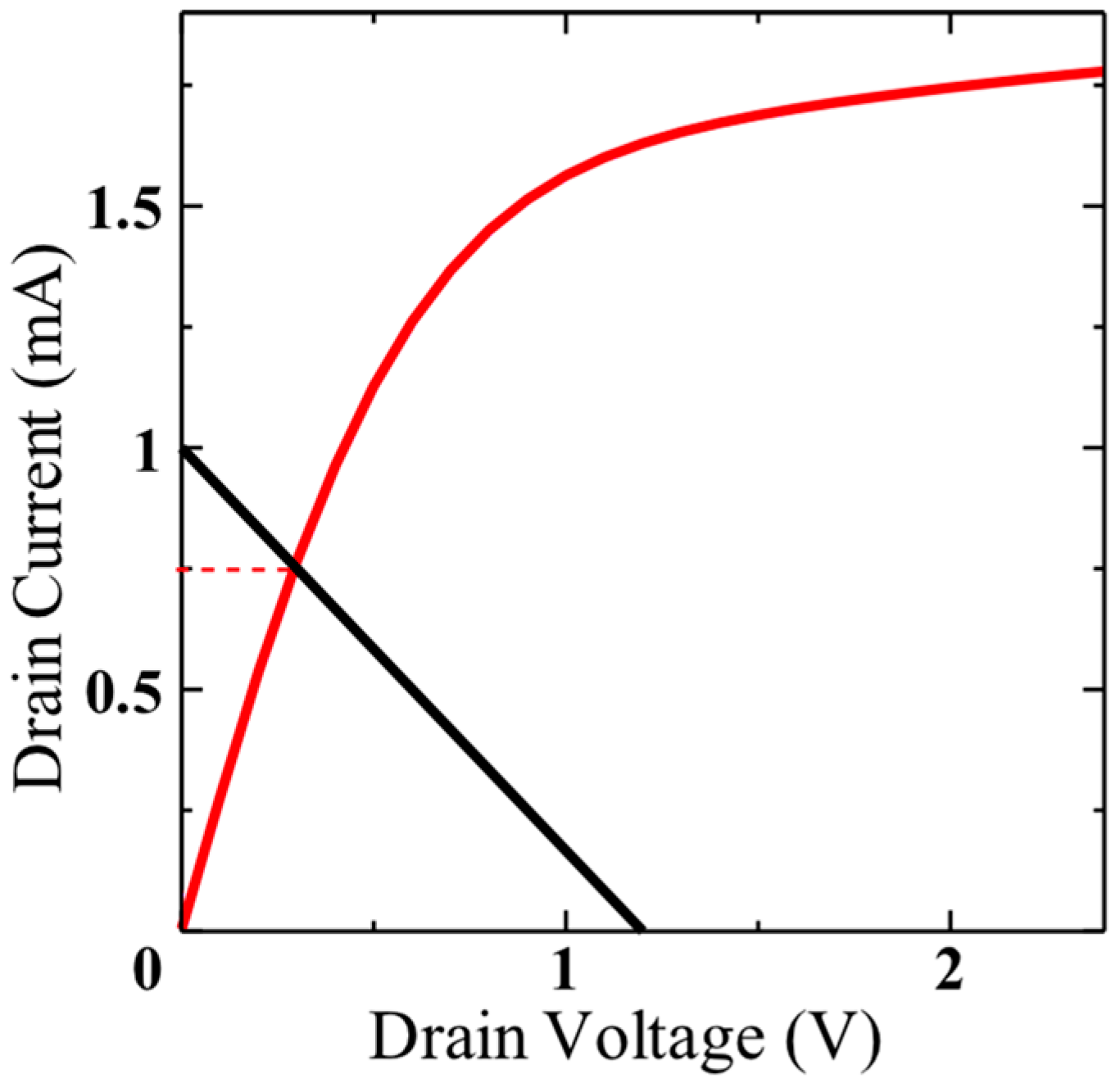
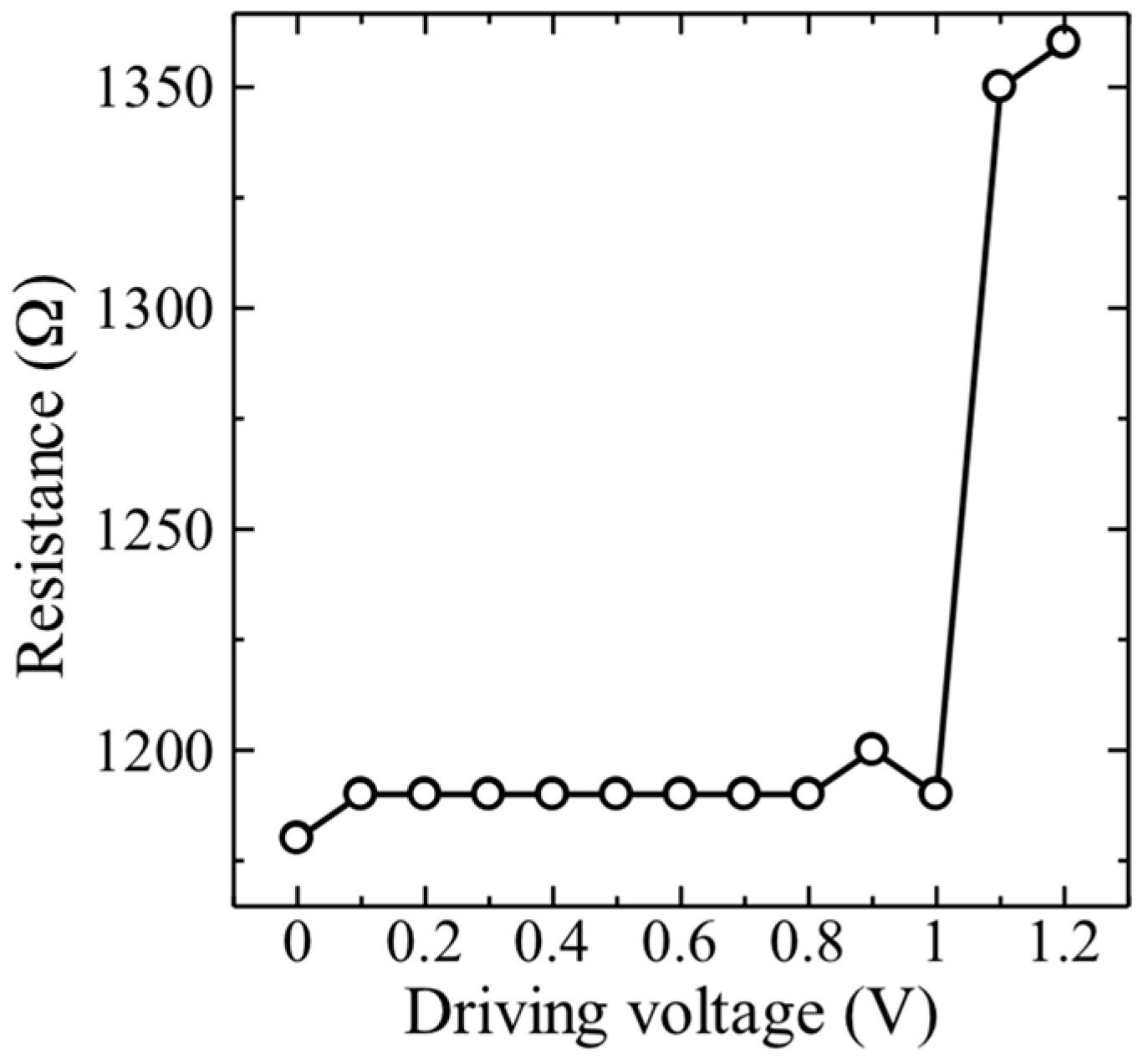
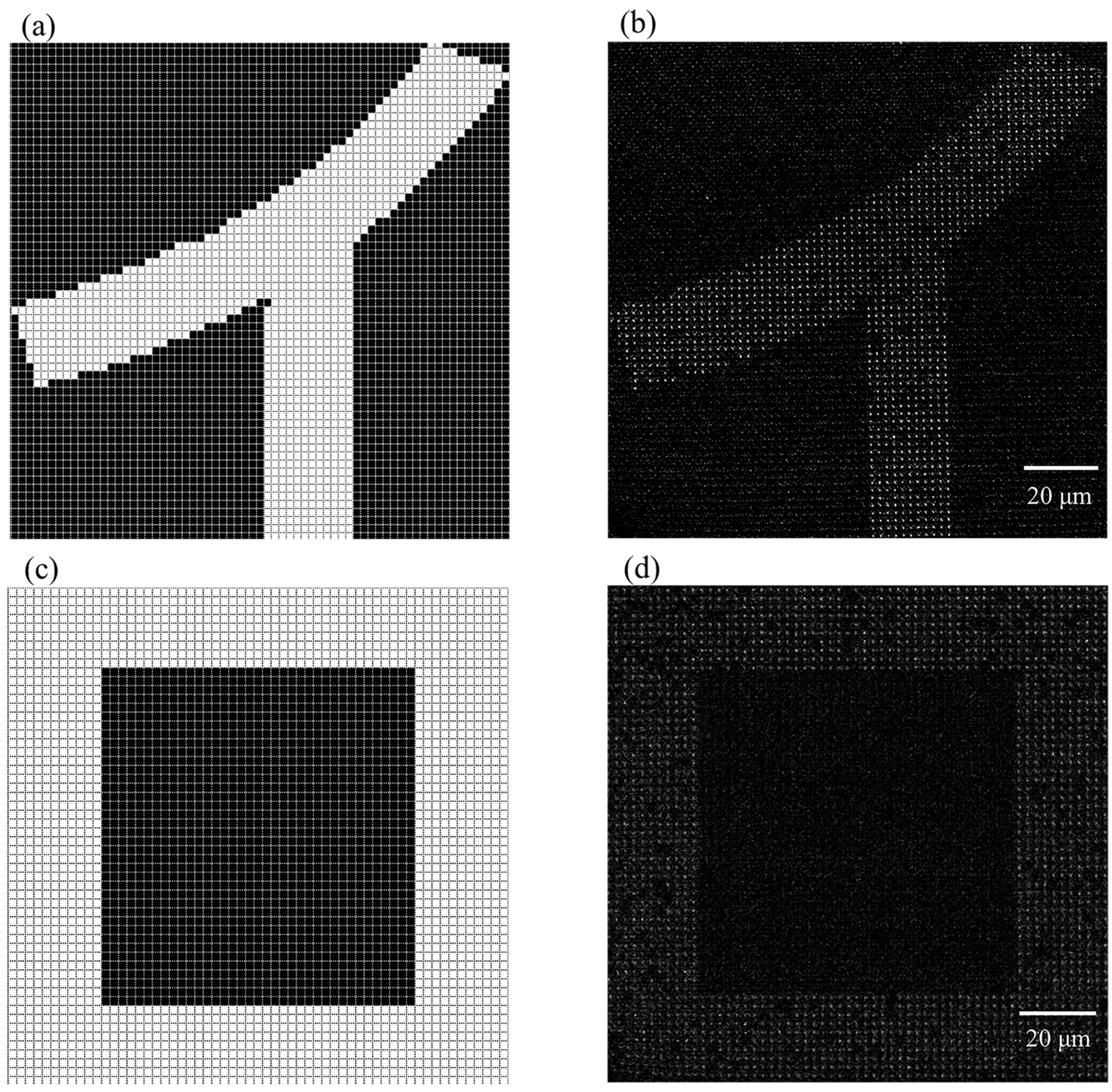
| Pixel Pitch of Spin-SLMs | 2 μm Pixel Pitch | 5 μm Pixel Pitch |
|---|---|---|
| MgO layer thickness | 1.0 nm | 0.8 nm |
| Average of resistance (arbitrarily selected) | 1150 Ω | 640 Ω |
| Standard deviation of resistance (arbitrarily selected) | 16.3 Ω | 47.5 Ω |
| Magnification | Exposure Time | Integration |
|---|---|---|
| 2000× | 0.1 s | 20 times |
© 2016 by the authors; licensee MDPI, Basel, Switzerland. This article is an open access article distributed under the terms and conditions of the Creative Commons Attribution (CC-BY) license (http://creativecommons.org/licenses/by/4.0/).
Share and Cite
Kinjo, H.; Aoshima, K.; Funabashi, N.; Usui, T.; Aso, S.; Kato, D.; Machida, K.; Kuga, K.; Ishibashi, T.; Kikuchi, H. Two Micron Pixel Pitch Active Matrix Spatial Light Modulator Driven by Spin Transfer Switching. Electronics 2016, 5, 55. https://doi.org/10.3390/electronics5030055
Kinjo H, Aoshima K, Funabashi N, Usui T, Aso S, Kato D, Machida K, Kuga K, Ishibashi T, Kikuchi H. Two Micron Pixel Pitch Active Matrix Spatial Light Modulator Driven by Spin Transfer Switching. Electronics. 2016; 5(3):55. https://doi.org/10.3390/electronics5030055
Chicago/Turabian StyleKinjo, Hidekazu, Kenichi Aoshima, Nobuhiko Funabashi, Takenobu Usui, Shintaro Aso, Daisuke Kato, Kenji Machida, Kiyoshi Kuga, Takayuki Ishibashi, and Hiroshi Kikuchi. 2016. "Two Micron Pixel Pitch Active Matrix Spatial Light Modulator Driven by Spin Transfer Switching" Electronics 5, no. 3: 55. https://doi.org/10.3390/electronics5030055
APA StyleKinjo, H., Aoshima, K., Funabashi, N., Usui, T., Aso, S., Kato, D., Machida, K., Kuga, K., Ishibashi, T., & Kikuchi, H. (2016). Two Micron Pixel Pitch Active Matrix Spatial Light Modulator Driven by Spin Transfer Switching. Electronics, 5(3), 55. https://doi.org/10.3390/electronics5030055




